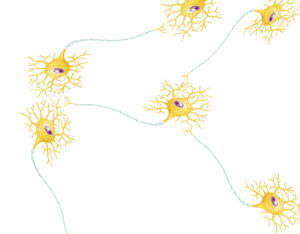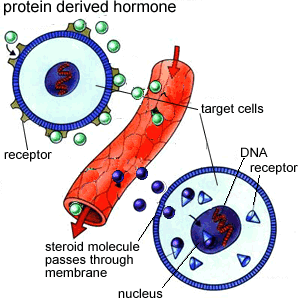Hormones
The brain controls the bodily functions by communicating with different parts of the body every second and at different times of development. Two ways of communicating is by chemical (hormonal) and by electrical (nervous system).
Nervous system conducts electrical signals quickly to different parts of the body. The signal lasts a short time.

The endocrine
system is a collection of special organs (glands) that
produce chemical messengers known as hormones and secrete them into the blood stream. These chemicals act locally
or travel through the blood to influence places far from where they
originated over a long period of time.
Exocrine glands are glands with ducts that secrete their products (including digestive enzymes, and some hormones) directly into the external environment via ducts. Endocrine glands, on the other hand, secrete their products (hormones) directly into the bloodstream or release hormones that affect specific target cells nearby. You may be familiar with some of these glands namely the sweat glands and salivary glands.
Below is a table of some of the special organs, their hormones and the action of each hormone.
When the hormones reach their target they bind to special molecules called receptors. Hormones can bind to receptors on the cell membrane or to receptors inside the cell. After binding to the receptors genes can be switched on or off.
Click to a slight larger animation.

Organ |
Hormone |
Action |
|
| Pancreas | Insulin | Insulin increases the uptake of glucose by cells. | |
| Adrenal gland | Adrenalin | Adrenalin is secreted under moments of stress and has the effect of increasing the heart rate, raising blood pressure, constricting blood vessels to the skin and causes a rise in blood sugar. All these factors make the person ready for physical action. | |
| Testes | Testosterone | Promotes growth of bone and the development of muscle in males during puberty. Changes that occur during puberty such as, facial hair, deepening of the voice are attributed to this hormone. | |
| Pituitary gland | Growth hormone | Growth hormone, among other hormones, stimulate linear skeletal growth in children and in adults stimulates protein synthesis in muscle and the release of fatty acids from adipose tissue. | |
| Ovaries | Oestrogen | Promotes development of breasts, hair and changes the shape of the hip bones. | |
| Kidneys | Erythropoetin | Promotes the production of red blood cells by the bone marrow. | |
Adrenalin is a hormone that is released during stress. Stress is good for athletes, prior to an event, as it causes the body to get ready for action. View the video on the right. 1) Explain what happens when a hormone reaches a cell. 2) The effect a hormone has on a traget cell can vary depending on what? 3) Adrenalin can cause the release of glucose from liver cells into the blood. This is due to chemical breakdown of glycogen but other, physical responses also take place as adrenalin targets more cells in the body. What are they? 4) Does adrenalin have the same effect on all muscle cells? Explain |
|||
| Continue with EPO, or Insulin | |||